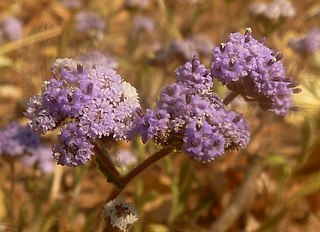
Brachystegia is a genus of tree of the subfamily Detarioideae that is native to tropical Africa.

Ocimum is a genus of aromatic annual and perennial herbs and shrubs in the family Lamiaceae, native to the tropical and warm temperate regions of all 6 inhabited continents, with the greatest number of species in Africa. Its best known species are the cooking herb basil, O. basilicum, and the medicinal herb tulsi, O. tenuiflorum.

The Afromontane regions are subregions of the Afrotropical realm, one of the Earth's eight biogeographic realms, covering the plant and animal species found in the mountains of Africa and the southern Arabian Peninsula. The Afromontane regions of Africa are discontinuous, separated from each other by lower-lying areas, and are sometimes referred to as the Afromontane archipelago, as their distribution is analogous to a series of sky islands.

Tecomaria capensis, the Cape honeysuckle, is a species of flowering plant in the family Bignoniaceae, native to southern Africa. Despite its common name, it is not closely related to the true honeysuckle.

The Cape serotine is a species of vesper bat occurring in Sub-Saharan Africa. 'Serotine' is from Latin 'serotinus' meaning 'of the evening'.

The African green pigeon is a species of bird in the family Columbidae, and one of 5 green pigeon species in the Afrotropics. The species has a wide range in Sub-Saharan Africa with around 17 accepted races.

The grey penduline tit, also known as the African penduline-tit, is a species of bird in the family Remizidae. It is found in Angola, Botswana, Burundi, Republic of the Congo, Democratic Republic of the Congo, Eswatini, Kenya, Malawi, Mozambique, Namibia, Rwanda, South Africa, Tanzania, Uganda, Zambia, and Zimbabwe. Its natural habitats are subtropical or tropical dry forests, dry savanna, and moist savanna. At 8 to 9 cm in length and a weight of 6.5 g (0.23 oz), it is one of the smallest species of bird found in Africa, along with its cousin the Cape penduline tit and the perhaps smaller mouse-colored penduline tit and the tit hylia.

The white-bellied sunbird, also known as the white-breasted sunbird, is a species of bird in the family Nectariniidae. It is found in Angola, Botswana, Democratic Republic of the Congo, Eswatini, Malawi, Mozambique, Namibia, South Africa, Tanzania, Zambia, and Zimbabwe.

The African broadbill, also known as the black-capped broadbill or Delacour's broadbill, is a species of bird in the sub-oscine family Calyptomenidae.

Vahlia is a genus of herbs and subshrubs that grow in Africa and the Indian subcontinent. There are at least five species.

Denekia is a genus of flowering plants in the family Asteraceae.

Piezia is a genus in the ground beetle family Carabidae. There are about 18 described species in Piezia, found in Africa.

Heteropaussus is a genus in the beetle family Carabidae. There are more than 20 described species in Heteropaussus.

Catunaregam is a genus of flowering plants in the family Rubiaceae, native to tropical Africa and tropical Southeast Asia.

Englerophytum is a group of trees in the family Sapotaceae described as a genus in 1914.

Cyphia is a genus of flowering plants in the bellflower family, native to Africa; and particularly South Africa. It has been placed in its own subfamily, Cyphioideae. It is closely related to the genus Lobelia.Cyphia comes in shades of white to mauve, whereas lobelias have strong colours of blue to purple. Species in this genus have a bilabiate corolla; with 3 lobes on top and 2 below.
This is a list of the Zimbabwe national football team results from 2000 to 2019.
Hilliardiella is a genus of flowering plants belonging to the family Asteraceae.

Tecomaria nyassae is a species of flowering plant in the family Bignoniaceae. The species is native to parts of southern and central Africa. The name refers to the area around Lake Nyassa also known as Lake Malawi.

















